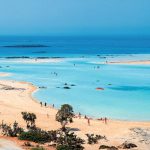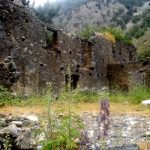Maleme
SOLON Apartments are located in the beautiful village Maleme, only 100m from Maleme beach.
At Maleme you can find lots of restaurants, cafeterias, tennis court, supermarket, free parking, medical facilities and bus stop.
Maleme beach is worth mentioning. It is wide and quite long with crystal clear sea. Maleme Beach wins the European "Blue Flag" every year. This means that there is a life guard and the beach is organized with free umbrellas and sun loungers. You can enjoy a hiking along the beach.
Maleme is located in West Crete, 15 kilometers from Chania City and 25 from Chania International Airport. Maleme is just 4 kilometres from the large seaside resort of Platanias.
Maleme location makes it a perfect holiday destination since it is next to the high way which connects Chania City with all the great sightseings such as Falassarna Beach, Elafonisi Beach, Balos & Gramvousa.
At Maleme you can find lots of restaurants, cafeterias, tennis court, supermarket, free parking, medical facilities and bus stop.
Maleme beach is worth mentioning. It is wide and quite long with crystal clear sea. Maleme Beach wins the European "Blue Flag" every year. This means that there is a life guard and the beach is organized with free umbrellas and sun loungers. You can enjoy a hiking along the beach.
Maleme is located in West Crete, 15 kilometers from Chania City and 25 from Chania International Airport. Maleme is just 4 kilometres from the large seaside resort of Platanias.
Maleme location makes it a perfect holiday destination since it is next to the high way which connects Chania City with all the great sightseings such as Falassarna Beach, Elafonisi Beach, Balos & Gramvousa.
View On Map
Sightseeing
Chania City
The city of Chania, the capital of the prefecture of Chania, the westernmost regional unit of Crete, is the most popular holiday destination in Crete and one of the most beautiful destinations in Greece.
The old town of Chania is considered as one of the most beautiful spots on Crete, with its jewel – the charming old Venetian harbour of Chania, ideal place for a morning coffee, sightseeing, romantic walks in the evening, shopping and nightlife.
During your sightseeing around the city and during your day trips throughout the county, you will be given the opportunity to see many historical monuments of the island.
Chania is a place where Minoans, Romans, Arabs, Venetians, Byzantines, Ottomans, Egyptians, Jews, lived, and they left their monuments, living example of the island’s rich history.
The old town of Chania is considered as one of the most beautiful spots on Crete, with its jewel – the charming old Venetian harbour of Chania, ideal place for a morning coffee, sightseeing, romantic walks in the evening, shopping and nightlife.
During your sightseeing around the city and during your day trips throughout the county, you will be given the opportunity to see many historical monuments of the island.
Chania is a place where Minoans, Romans, Arabs, Venetians, Byzantines, Ottomans, Egyptians, Jews, lived, and they left their monuments, living example of the island’s rich history.
Falassarna beach
Falassarna beach is a long sandy beach with wonderful sunsets. It has been voted for Best Beach of Greece. There are several beaches in the Falassarna bay:
– small sandy beaches close to the ancient Falassarna town (north)
– the “Long Beach” or “Pachia Ammos”, which is the famous long and wide sandy beach of Falassarna.
– another sandy beach with a rocky seabed (south). No facilities here.
– a small pebbly beach close to the port of Falassarna (south). No sunbeds and umbrellas.
– small sandy beaches close to the ancient Falassarna town (north)
– the “Long Beach” or “Pachia Ammos”, which is the famous long and wide sandy beach of Falassarna.
– another sandy beach with a rocky seabed (south). No facilities here.
– a small pebbly beach close to the port of Falassarna (south). No sunbeds and umbrellas.
Elafonissi
Elafonissi is in west Crete, 75 kilometres southwest of Chania. The Elafonissi area includes the beach, the islet 200 metres offshore and the shallow lagoon between the two. Elafonissi is a tiny island with white sand, separated from the shore by a lagoon no more than a metre deep. Elafonissi means “deer island”, but you won’t see any deer on the island or in the surrounding area.
The island is less than 200 metres from the beach and you can easily walk there through the warm, shallow water of the lagoon. On reaching the island you will discover lots of tiny beaches on its south coast.
The beaches both on the islet and the mainland opposite to it, are considered to be amongst the best in Crete and Greece. The fine white sand and the turquoise waters compose an exotic scenery.
Elefonissi belongs to the micro – reserve network of Crete (Natura 2000) with main protected species being the endangered Androcymbium rechingeri.
The island is less than 200 metres from the beach and you can easily walk there through the warm, shallow water of the lagoon. On reaching the island you will discover lots of tiny beaches on its south coast.
The beaches both on the islet and the mainland opposite to it, are considered to be amongst the best in Crete and Greece. The fine white sand and the turquoise waters compose an exotic scenery.
Elefonissi belongs to the micro – reserve network of Crete (Natura 2000) with main protected species being the endangered Androcymbium rechingeri.
Balos & Gramboussa
Balos beach and the island Gramboussa located in the northwestern end of Crete, in the prefecture of Chania.
Balos is the exotic beach-lagoon formed between the peninsula of Gramvousa and Cape Tigani and Gramboussa (Imeri “Domesticated” Gramboussa), one of the two islands just across from the lagoon of Balos, while a little further north is the second island, Wild Gramboussa. In Balos and Imeri Gramboussa you can go on a cruise ship from the port of Kissamos. To Balos and only you can go by yourself, drive up to a point and then walking.
Nothing can make you feel what you experience when you come to Balos!
When you walk through the peaceful lagoon.
When you swim in the warm, shallow, crystal, emerald, aquamarine waters.
When you relax on white sand beach under the hot sun (pink in some places from the dust of crushed seashells).
When you notice the wild natural beauty of the rocks and slopes to rise over your head.
Balos is the exotic beach-lagoon formed between the peninsula of Gramvousa and Cape Tigani and Gramboussa (Imeri “Domesticated” Gramboussa), one of the two islands just across from the lagoon of Balos, while a little further north is the second island, Wild Gramboussa. In Balos and Imeri Gramboussa you can go on a cruise ship from the port of Kissamos. To Balos and only you can go by yourself, drive up to a point and then walking.
Nothing can make you feel what you experience when you come to Balos!
When you walk through the peaceful lagoon.
When you swim in the warm, shallow, crystal, emerald, aquamarine waters.
When you relax on white sand beach under the hot sun (pink in some places from the dust of crushed seashells).
When you notice the wild natural beauty of the rocks and slopes to rise over your head.
Samaria Gorge
The Gorge of Samaria is the second most visited tourist attraction on Crete (following the Minoan palace of Knossos) and by far the most popular walk. More than a quarter million people walk through the gorge every year from May to October. In winter the gorge is closed to visitors due to danger posed by water and falling stones. But you must realise that it is a long (5 to 7 hours) walk on rough terrain so you will need to have a certain degree of fitness and walking experience in order to enjoy it.
The most famous part of the gorge is the stretch known as the Gates (or, albeit incorrectly, as “Iron Gates”), where the sides of the gorge close in to a width of only four meters and soar up to a height of almost 300 meters (980 feet). The gorge became a national park in 1962, particularly as a refuge for the rare kri-kri (Cretan goat), which is largely restricted to the park and an island just off the shore of Agia Marina. There are several other endemic species in the gorge and surrounding area, as well as many other species of flowers and birds. The village of Samariá lies just inside the gorge. It was finally abandoned by the last remaining inhabitants in 1962 to make way for the park. The village and the gorge take their names from the village’s ancient church, Óssia María.
A must for visitors to Crete is to complete the walk down the gorge from the Omalos plateau to Agia Roumeli on the Libyan Sea, at which point tourists sail to the nearby village of Sougia or Hora Sfakion, where they could spend a night there, or they could catch a coach back to Chania.
The most famous part of the gorge is the stretch known as the Gates (or, albeit incorrectly, as “Iron Gates”), where the sides of the gorge close in to a width of only four meters and soar up to a height of almost 300 meters (980 feet). The gorge became a national park in 1962, particularly as a refuge for the rare kri-kri (Cretan goat), which is largely restricted to the park and an island just off the shore of Agia Marina. There are several other endemic species in the gorge and surrounding area, as well as many other species of flowers and birds. The village of Samariá lies just inside the gorge. It was finally abandoned by the last remaining inhabitants in 1962 to make way for the park. The village and the gorge take their names from the village’s ancient church, Óssia María.
A must for visitors to Crete is to complete the walk down the gorge from the Omalos plateau to Agia Roumeli on the Libyan Sea, at which point tourists sail to the nearby village of Sougia or Hora Sfakion, where they could spend a night there, or they could catch a coach back to Chania.






























